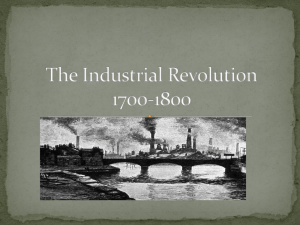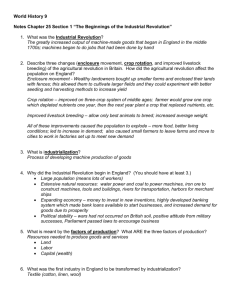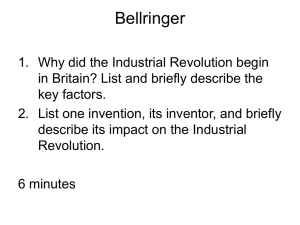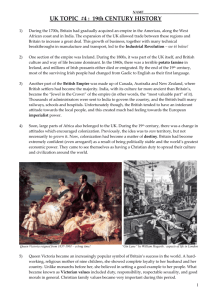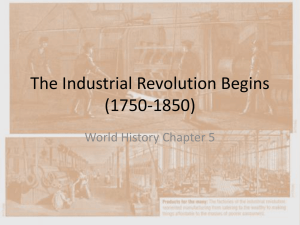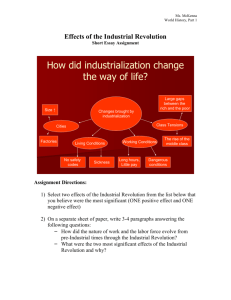Industrial Revolution
advertisement
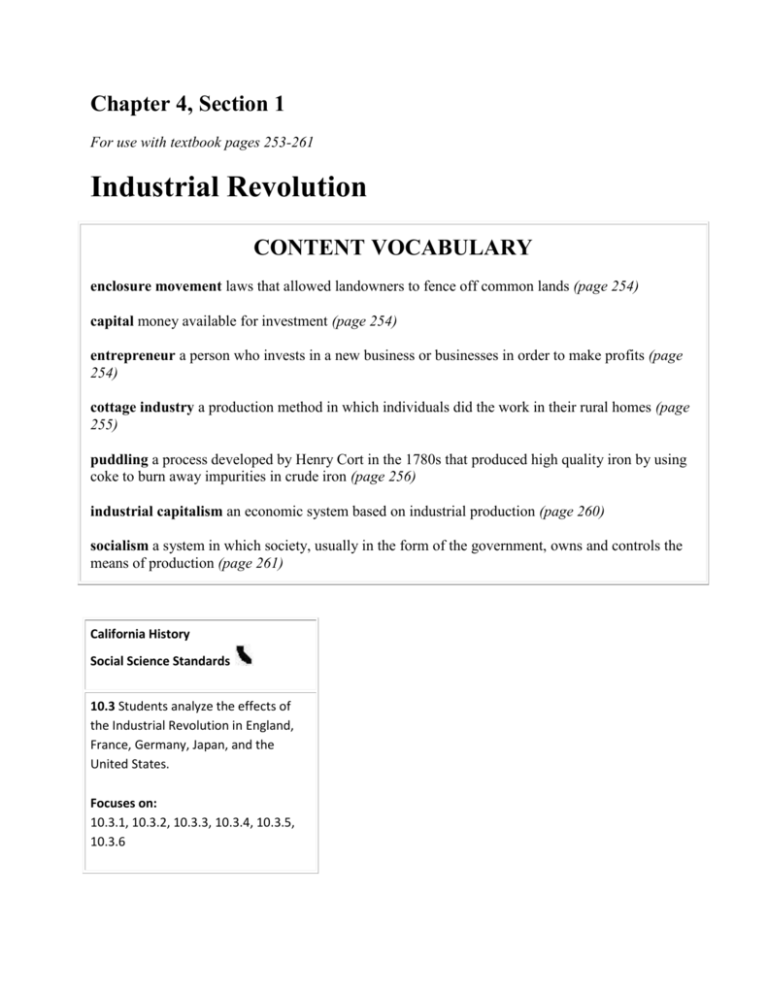
Chapter 4, Section 1 For use with textbook pages 253-261 Industrial Revolution CONTENT VOCABULARY enclosure movement laws that allowed landowners to fence off common lands (page 254) capital money available for investment (page 254) entrepreneur a person who invests in a new business or businesses in order to make profits (page 254) cottage industry a production method in which individuals did the work in their rural homes (page 255) puddling a process developed by Henry Cort in the 1780s that produced high quality iron by using coke to burn away impurities in crude iron (page 256) industrial capitalism an economic system based on industrial production (page 260) socialism a system in which society, usually in the form of the government, owns and controls the means of production (page 261) California History Social Science Standards 10.3 Students analyze the effects of the Industrial Revolution in England, France, Germany, Japan, and the United States. Focuses on: 10.3.1, 10.3.2, 10.3.3, 10.3.4, 10.3.5, 10.3.6 • The Industrial Revolution in Great Britain (page 254) The Industrial Revolution began in Great Britain in the 1780s. There were several reasons why this dynamic process started there. First, agricultural practices in the eighteenth century had changed. More people could be fed at lower prices with less labor. Now even ordinary British families had money to buy manufactured goods. Second, with more abundant food supplies, the population grew. This increase created a large labor force to work in the new factories in Britain. Third, Britain had money to invest in the new industrial machines and factories. This money is called capital. Many British people were very wealthy and were interested in finding new business opportunities and new ways to make profits. These people are called entrepreneurs. Fourth, natural resources, such as coal and iron ore, were plentiful in Britain. Fifth, Britain had a free society that did not place many regulations on trade. Finally, Britain had a huge empire that gave the British many markets for their goods. Academic Vocabulary dynamic: marked by a continuous and productive activity or change (p. 254) One of the main industries in Great Britain was the production of inexpensive cotton goods. There were two steps in the manufacture of cotton cloth—spinning (making thread) and weaving (turning the thread into cloth). Originally, the work was done by individuals in their rural homes. This production method is known as cottage industry. Advances in technology made cottage industry inefficient, however. The invention of the "flying shuttle" made weaving faster. Weavers now needed more thread from spinners. In 1764, James Hargreaves had invented a spinning machine called the spinning jenny, which made the spinning process faster. In fact, thread was being produced faster than weavers could use it. By 1787, Edmund Cartwright had invented a water-powered loom that made it possible for the weaving of cloth to catch up with the spinning of thread. It now became more efficient to do the work in factories, which were located near streams and rivers. The cotton industry became even more productive when the steam engine was improved by a Scottish engineer, James Watt. Watt made changes that allowed the engine to drive machinery. Steam power could now be used to spin and weave cotton. Before long, cotton mills were found all over Britain. By 1840, cotton cloth was Britain's most valuable product. British cotton goods were sold everywhere in the world and were produced mainly in factories. The steam engine was crucial to Britain's Industrial Revolution. For fuel, the engine depended on coal. The need for coal led to an increase in coal production. The need for coal increased even more when Henry Cort developed a process called puddling. In this process, coke (which was derived from coal) was used to burn away impurities in crude iron. This produced a better quality of iron. The British iron industry boomed. The high-quality iron was used to build new machines, especially new means of transportation. Railroads were particularly important to the success of the Industrial Revolution. In 1804, the first steam-powered locomotive ran on an industrial rail-line in Britain. By 1850, there were over 6,000 miles of railroad track across the country. Building railroads created new jobs for farm laborers and peasants. Less expensive transportation led to lower-priced goods, which created larger markets. More sales meant more factories and more machinery. Factories created a new labor system. Factory owners wanted to use their new machines constantly. As a result, workers were forced to work in shifts to keep the machines running all day. Workers migrated from rural areas, where they were used to hectic work followed by periods of rest. Factory owners created a system in which employees became used to working set hours and doing the same work over and over. Adult workers were fined or fired for being late or for other misconduct. Child workers were often beaten. Academic Vocabulary migrate: to move from one country, place, or locality to another (p. 257) • The Spread of Industrialization (page 257) By the mid-nineteenth century, Great Britain had become the world's first and richest industrial nation. It produced one-half of the world's coal and manufactured goods. The Industrial Revolution spread to the rest of Europe at different times and speeds. The first countries to be industrialized in continental Europe were Belgium and France. Industrialization came later in central Europe because the German states were not unified until 1870. Japan was the only Asian country to follow the Western example. In 1853, American admiral Perry demanded that Japan trade with the United States. Japan decided it must copy western technology to become a strong nation. However, these governments were very active in encouraging the development of industrialization. An Industrial Revolution also occurred in the new nation of the United States. In 1800, six out of every seven American workers were farmers. By 1860, only 50 percent of American workers were farmers. Labor for the growing number of factories in the Northeast came mainly from the farm population. Many of the workers in the new factories were women. In fact, women and girls made up the majority of the workers in large textile factories. The United States was a large country in the 1800s. A transportation system to move goods across the nation was vital. Thousands of miles of roads and canals were built to link east and west. Robert Fulton built the first paddlewheel steamboat in 1807. By 1860, there were a thousand steamboats on the Mississippi River. The railroad was the most important part of the American transportation system. By 1860, about 30,000 miles of railroad track covered the United States. • Social Impact in Europe (page 259) The Industrial Revolution drastically changed the social life of Europe and the world. By 1850, the population of Europe had almost doubled to 266 million. The key to this growth was a decline in death rates, wars, and diseases. Because of an increase in the food supply, more people were better fed and resistant to diseases. Famine disappeared from most of western Europe. Cities and towns grew dramatically in the first half of the nineteenth century. The growth was directly related to industrialization. People moved from the country to the cities to find work in factories. The rapid growth of cities led to pitiful living conditions for many people, however. With the Industrial Revolution came the rise of industrial capitalism, an economic system based on industrial production. Industrial capitalism produced a new middle-class group—the industrial middle class. The new industrial middle class was made up of the people who built the factories, bought the machines, and figured out where the markets were. Their qualities included initiative, vision, ambition, and often, greed. The Industrial Revolution also created an industrial working class. Industrial workers had terrible working conditions. Work hours ranged from 12 to 16 hours a day, six days a week, with a halfhour for lunch and dinner. The worst conditions were in the cotton mills. The mills were hot, dirty, dusty, dangerous, and unhealthy. In Britain, women and children made up twothirds of the cotton industry's workforce by 1830. However, the number of children declined under the Factory Act of 1833, which set 9 as the minimum age for employment. As the number of children declined, women took their places. They were mostly unskilled labor and were paid half, or less than half, of what men received. Excessive working hours for women were outlawed in 1844. The laws that limited the work hours of children and women gradually led to a new pattern of work. In cottage industry, husband, wife, and children had always worked together. Men were now expected to earn most of the family income by working outside the home. Women took over daily care of the family and performed low-paying jobs, such as laundry work, that could be done in the home. In the first half of the nineteenth century, the pitiful conditions created by the Industrial Revolution gave rise to a movement known as socialism. Socialism is a system in which society, usually through government, owns and controls some means of production (factories and utilities, for example). Early socialism was primarily the idea of intellectuals who believed in the equality of all people and who wanted to replace competition with cooperation in industry. Later socialists called these early socialists utopians because they thought their ideas were impractical dreams. Robert Owen, a British cotton manufacturer, was one utopian socialist. He believed that humans would show their natural goodness if they lived in a cooperative environment. He formed two communities, one at New Lanark in Scotland and one at New Harmony, Indiana. The community at New Lanark flourished, but the one at New Harmony failed.
